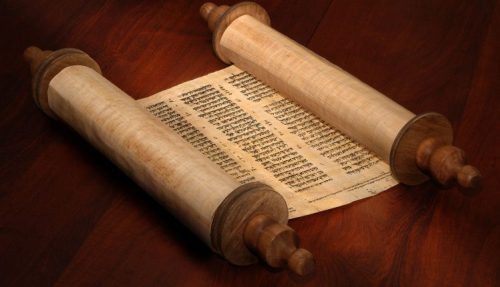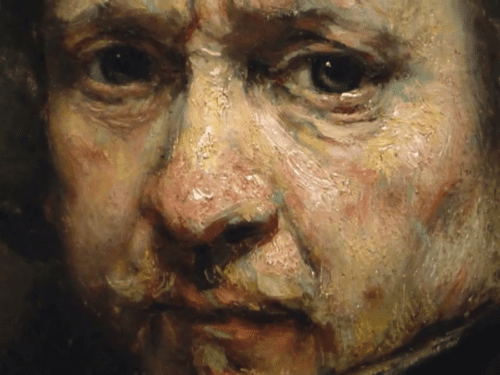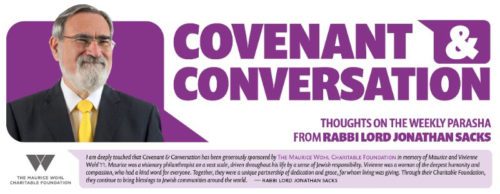

In Ki Tissa and in Vayakhel we encounter the figure of Betzalel, a rare type in the Hebrew Bible – the artist, the craftsman, the shaper of beauty in the service of God, the man who, together with Oholiab, fashioned the articles associated with the Tabernacle. Judaism – in sharp contrast to ancient Greece – did not cherish the visual arts. The reason is clear. The biblical prohibition against graven images associates them with idolatry. Historically, images, fetishes, icons and statues were linked in the ancient world with pagan religious practices. The idea that one might worship “the work of men’s hands” was anathema to biblical faith.
More generally, Judaism is a culture of the ear, not the eye.[1] As a religion of the invisible God, it attaches sanctity to words heard, rather than objects seen. Hence there is a generally negative attitude within Judaism towards representational art.
There are some famous illustrated manuscripts (such as the Bird’s Head Haggadah, Bavaria, circa 1300) in which human figures are given bird’s heads to avoid representing the full human form. Art is not forbidden as such; there is a difference between three-dimensional and two-dimensional representation. As Rabbi Meir of Rothenburg (c. 1215–1293) made clear in a responsum, “There is no trespass [in illustrated books] against the biblical prohibition…[illustrations] are merely flat patches of colour lacking sufficient materiality [to constitute a graven image].”[2] Indeed several ancient synagogues in Israel had quite elaborate mosaics. In general, however, art was less emphasised in Judaism than in Christian cultures in which the Hellenistic influence was strong.
Positive references to art in the rabbinic literature are rare. One exception is Maimonides, who says the following:
If one is afflicted with melancholy, he should cure it by listening to songs and various kinds of melodies, by walking in gardens and fine buildings, by sitting before beautiful forms, and by things like this which delight the soul and make the disturbance of melancholy disappear from it. In all this he should aim at making his body healthy, the goal of his body’s health being that he attain knowledge.[3]
The very terms in which Maimonides describes the aesthetic experience make it clear, however, that he sees art in strictly instrumental terms, as a way of relieving depression. There is no suggestion that it has value in its own right.
The strongest positive statement on art of which I am aware was made by Rabbi Abraham ha-Cohen Kook, the first Ashkenazi Chief Rabbi of (pre-State) Israel, describing his time in London during the First World War:
When I lived in London, I would visit the National Gallery, and the paintings that I loved the most were those of Rembrandt. In my opinion Rembrandt was a saint. When I first saw Rembrandt’s paintings, they reminded me of the rabbinic statement about the creation of light. When God created the light [on the first day], it was so strong and luminous that it was possible to see from one end of the world to the other. And God feared that the wicked would make use of it. What did He do? He secreted it for the righteous in the world to come. But from time to time there are great men whom God blesses with a vision of that hidden light. I believe that Rembrandt was one of them, and the light in his paintings is that light which God created on Genesis day.[4]
Rembrandt is known to have had a special affection for Jews.[5] He visited them in his home town of Amsterdam, and painted them, as well as many scenes from the Hebrew Bible. I suspect that what Rabbi Kook saw in his paintings, though, was Rembrandt’s ability to convey the beauty of ordinary people. He makes no attempt (most notably in his self-portraits) to beautify or idealise his subjects. The light that shines from them is, simply, their humanity.
It was Samson Raphael Hirsch who distinguished ancient Greece from ancient Israel in terms of the contrast between aesthetics and ethics. In his comment on the verse “May God enlarge Japheth and let him dwell in the tents of Shem” (Genesis 9:27), he observes:
The stem of Japheth reached its fullest blossoming in the Greeks; that of Shem in the Hebrews, Israel, who bore and bear the name (Shem) of God through the world of nations…Japheth has ennobled the world aesthetically. Shem has enlightened it spiritually and morally.[6]
Yet as we see from the case of Betzalel, Judaism is not indi?erent to aesthetics. The concept of hiddur mitzvah, “beautifying the commandment,” meant, for the sages, that we should strive to fulfil the commands in the most aesthetically pleasing way. The priestly garments were meant to be “for honour and adornment” (Exodus 28:2). The very terms applied to Betzalel – wisdom, understanding and knowledge – are applied by the book of Proverbs to God Himself as creator of the universe:
The law and the Lord founded the earth by wisdom;
He established the heavens by understanding;
By His knowledge the depths burst apart,
And the skies distilled dew. (Proverbs: 3:19–20)
The key to Betzalel lies in his name. It means “In the shadow of God.” Betzalel’s gift lay in his ability to communicate, through his work, that art is the shadow cast by God. Religious art is never “art for art’s sake.”[7] Unlike secular art, it points to something beyond itself. The Tabernacle itself was a kind of microcosm of the universe, with one overriding particularity: that in it you felt the presence of something beyond – what the Torah calls “the glory of God” which “filled the Tabernacle” (Exodus 40:35).
The Greeks, and many in the Western world who inherited their tradition, believed in the holiness of beauty (Keats’ “Beauty is truth, truth beauty, that is all / Ye know on earth, and all ye need to know”).[8] Jews believed in the opposite: hadrat kodesh, the beauty of holiness: “Give to the Lord the glory due to His name; worship the Lord in the beauty of holiness” (Psalms 29:2). Art in Judaism always has a spiritual purpose: to make us aware of the universe as a work of art, testifying to the supreme Artist, God Himself.
Shabbat Shalom.

[1] For a more nuanced view, however, see Kalman Bland, The Artless Jew: Medieval and Modern A?rmations and Denials of the Visual (Princeton University Press, 2001).
[2] See Tosafot, commentary to Yoma 54a–b, s.v. Keruvim; Responsa Rabbi Meir Mi’Rothenberg (Venice: 1515), 14–16.
[3] Rambam, introduction to commentary on Mishna Avot, Eight Chapters on Ethics, chap. 5. 298.
[4] Jewish Chronicle, September 9, 1935
[5] See Michael Zell, Reframing Rembrandt: Jews and the Christian Image in Seventeenth- Century Amsterdam (University of California Press, 2002), and Steven Nadler, Rembrandt’s Jews (University of Chicago Press, 2003).
[6] The Pentateuch, translated with commentary by Samson Raphael Hirsch (Gates- head: Judaica Press, 1982), 1:191.
[7] The phrase is usually attributed to Benjamin Constant (1804).
[8] The last lines of Keats’ famous poem, “Ode on a Grecian Urn.”

An international religious leader, philosopher, award-winning author and respected moral voice, Rabbi Lord Jonathan Sacks was awarded the 2016 Templeton Prize in recognition of his “exceptional contributions to affirming life’s spiritual dimension.” Described by H.R.H. The Prince of Wales as “a light unto this nation” and by former British Prime Minister Tony Blair as “an intellectual giant”, Rabbi Sacks is a frequent and sought-after contributor to radio, television and the press both in Britain and around the world.
Since stepping down as the Chief Rabbi of the United Hebrew Congregations of the Commonwealth – a position he served for 22 years between 1991 and 2013 – Rabbi Sacks has held a number of professorships at several academic institutions including Yeshiva University and King’s College London. In addition to his writing and lecturing, he currently serves as the Ingeborg and Ira Rennert Global Distinguished Professor at New York University. Rabbi Sacks has been awarded 17 honorary doctorates including a Doctor of Divinity conferred to mark his first ten years in office as Chief Rabbi, by the then Archbishop of Canterbury, Lord Carey.
Rabbi Sacks is the author of over 30 books. Among them, Rabbi Sacks has published a new English translation and commentary for the Koren Sacks Siddur, the first new Orthodox siddur in a generation, as well as powerful commentaries for the Rosh HaShana, Yom Kippur, Pesach, Shavuot and Sukkot Machzorim. His most recent work, Not in God’s Name: Confronting Religious Violence was awarded a 2015 National Jewish Book Award in America and was a top ten Sunday Times bestseller in the UK. Past works include: The Great Partnership: God, Science and the Search for Meaning; The Dignity of Difference: How to Avoid the Clash of Civilizations, winner of the Grawemeyer Prize for Religion in 2004 for its success in defining a framework for interfaith dialogue between people of all faith and of none; To Heal a Fractured World: The Ethics of Responsibility; and A Letter in the Scroll: On Being Jewish, winner of a National Jewish Book Awards in 2000. His Covenant & Conversationcommentaries on the weekly Torah portion are read in Jewish communities around the world.
In recognition of his work, Rabbi Sacks has received, among others, the Jerusalem Prize in 1995 for his contribution to diaspora Jewish life, The Ladislaus Laszt Ecumenical and Social Concern Award from Ben Gurion University in Israel in 2011, The Guardian of Zion Award from the Ingeborg Rennert Center for Jerusalem Studies at Bar-Ilan University in 2014, and The Katz Award in recognition of his contribution to the practical analysis and application of Halakha in modern life in Israel in 2014. He was named as The Becket Fund’s 2014 Canterbury Medalist for his role in the defence of religious liberty in the public square; won a Bradley Prize in 2016 in recognition of being “a leading moral voice in today’s world”; and in 2017, he was awarded the Irving Kristol Award from the American Enterprise Institute for his “remarkable contributions to philosophy, religion, and interfaith discourse… as one of the world’s greatest living public intellectuals.” In 2018, he was given the Lifetime Achievement Award by The London Jewish News in recognition of his services to the Jewish world and wider society.
Rabbi Sacks was knighted by Her Majesty The Queen in 2005 and made a Life Peer, taking his seat in the House of Lords in October 2009. Born in 1948 in London, he has been married to Elaine since 1970. They have three children and several grandchildren.